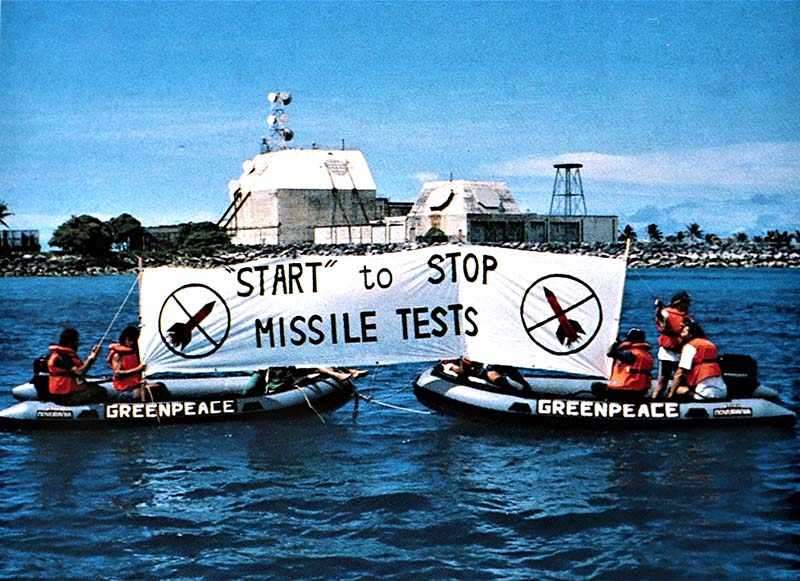It seems that we just can’t escape the nuclear madness at the moment. Last week, US President Trump instructed the Pentagon to immediately start matching other nuclear weapon states in their testing of nuclear weapons, citing Russia and China.
It reminded me of an intense moment in A House of Dynamite (AHOD) shortly before an incoming nuclear missile of unknown North Pacific origin was about to hit Chicago. During a Zoom-like crisis conference, a fictional US general asks the fictional US president whether to retaliate by launching a nuclear strike against Russia, China and North Korea. The president exclaims, “This is insanity” and the general replies tersely, “No sir, this is reality.”
And there you have the insanely M.A.D. logic of nuclear deterrence, as portrayed in Kathryn Bigelow’s new apocalyptic 92-minute war drama which was recently released to Netflix in Aotearoa, landing straight at the number one spot.
The film’s cliffhanger ending leaves viewers to contemplate the appalling outcome. But if there is any doubt about the consequences of a nuclear attack, the 2024 bestselling non-fiction book Nuclear War: A Scenario by Annie Jacobsen lays out how it could escalate into a global nuclear war in just 72 minutes, causing a nuclear winter and killing 5 billion people.
AHOD is timely. The 2025 annual report of the Stockholm International Peace Research Institute (SIPRI) describes how Russia, China and the US are reportedly expanding and modernising their nuclear arsenals, including their intercontinental ballistic missiles (ICBMs). So, just at the time when the world desperately needs to be investing more in renewables and climate action, they are spending billions on new and more deadly ways to fight a nuclear war.
In February 2026, the START (Strategic Arms Reduction) Treaty between the US and Russia, which caps the numbers of weapons, will expire. After that, SIPRI says, Russia could theoretically divert hundreds of warheads to its deployed missile delivery systems, potentially increasing its deployed nuclear arsenal by up to 60 per cent.
Since Russia’s full scale invasion of Ukraine in February 2022, Moscow has carried out regular ballistic and cruise missile strikes into Ukraine using its (non-nuclear armed) missiles, such as the Kh-101 and Kh-22 air-launched cruise missiles, sea-launched 3M-54 Kalibr cruise missiles, and ground-launched 9-A-7760 Kinzhal ballistic missiles, Iskander missiles and Kh-55 cruise missiles.
Each attack is devastating in itself, but taken together they make up a prolonged multi-year battlefield proving ground for refining Russia’s ballistic and cruise missile systems and related war-fighting tactics.
And just two weeks ago, Russia reportedly tested its ‘triad’ of nuclear weapons delivery systems, consisting of land-based intercontinental ballistic missiles (ICBMs), submarine-launched ballistic missiles (SLBMs), and strategic bombers. Then just last week, President Putin announced that Russia had successfully tested its Burevestnik nuclear-powered, ground-launched, nuclear-armed cruise missile, which is reportedly designed to carry a 300 kiloton nuclear warhead and has an intercontinental range. That is 20 times the destructive power of the nuclear weapon the US dropped on the Japanese city of Hiroshima on 6 August 1945, which killed an estimated 140,000 people.
President Putin asserts that no other country has anything like the new Burevestnik missile, because he claims it is a low flying weapon with a nearly unlimited range, an unpredictable flight path, and so is “invincible” in the face of current and future defences.
Independent experts are more sceptical, saying its subsonic speed of 600 mph would make it detectable and therefore vulnerable to counter-measures. It has also been described as a “flying Chernobyl” because it has a nuclear thermal rocket engine which potentially spews out radioactive ‘exhaust’ during flight.
The race to modernise ballistic missiles and build new hypersonic missiles
Russia is not alone in modernising its ballistic missiles and developing a new hypersonic missile. In 2023, North Korea reportedly carried out four successful ICBM flight tests over the Sea of Japan, including its newest and most advanced Hwasong-18 missile, which can reach anywhere in the continental US. It is also developing sea-launched ballistic missiles (SLBMs), including the Pukguksong-6, which has a reported estimated range of 4,000 to 12,000 km and multiple warheads. They also reportedly tested a hypersonic missile last month.
China reportedly has seven types of hypersonic ballistic and cruise missiles (DF-17, DF-ZF, DF-27, DF-21, YJ-17, YJ-19, CJ-1000), several of which were officially unveiled during the 2025 China Victory Day Parade in Beijing in September 2025. The same month, China reportedly carried out a flight test of a new variant of one of its intercontinental ballistic missiles, which was equipped with “hypersonic boost-glide technology”.
India is reported to have successfully tested a hypersonic cruise missile (ET-LDHCM) in July 2025 and is also reportedly developing a long-range ground-launched hypersonic missile (Dhwani) for readiness in 2029 and preparing a new long-range submarine-launched hypersonic ballistic missile (K-6) for sea trials.
The US is reportedly developing and testing a long-range hypersonic missile (Dark Eagle) and a hypersonic attack cruise missile, which is reportedly due for delivery in 2027.
Britain is due to have a hypersonic cruise missile operational by 2030 after announcing a successful static test of a high-speed air-breathing engine concept in cooperation with the US in April 2025.
France is developing its own nuclear-armed air-launched hypersonic cruise missile (ASN4G), which is due for deployment on its Rafale F5 jets in 2035.
And Pakistan’s Air Force has reportedly announced the existence of a hypersonic missile capability as part of a wider modernisation of its military.
This means all of the declared nuclear weapon states have either now developed or are testing hypersonic missile technologies.
What makes these missiles so destabilising is their extremely high speed and ability to manoeuvre in flight, which makes them difficult to detect, track and intercept, thereby dramatically cutting decision-making time for defending against them.
Unlike the current generation of ballistic missiles, which follow a more predictable arc flight path, once they are in high orbit, hypersonic weapons can change course while gliding down, making them extremely difficult to predict and intercept with existing systems. They also undermine nuclear deterrence by potentially creating a scenario in which a “first strike” becomes more feasible and survivable, hence the new hypersonic arms race in which multiple countries are rushing to develop new offensive and defensive capabilities.
Alongside the current range of wars and armed conflicts in the world, and the existence of ‘M.A.D.’ nuclear deterrence doctrines, the development of new and more deadly nuclear-capable delivery systems from ICBMs and SLBMs to hypersonic missiles greatly complicates the situation by heightening the risks.
Add to that the existence of volatile and autocratic political leadership in some nuclear weapon states, and the potential for the appointment of unqualified people to high military office (who knew a former NBC reality TV presenter would one day become US President and appoint a former Fox TV presenter as head of the US Department of Defense?), and there’s a heightened risk of unpredictable behaviour and nuclear miscalculation.
Ways out of a hypersonic nuclear arms race?
The lesson of AHOD is that it’s better to avoid a nuclear attack in the first place because once a nuclear weapon reaches terminal velocity, there’s no stopping it. So, what can be done to avoid the nightmare scenario of a nuclear war breaking out at hypersonic speed?
During the Cold War, from 1971 to 1996, Greenpeace and many others – including successive New Zealand governments – successfully campaigned to end nuclear warhead testing and agree a Comprehensive Test Ban Treaty (CTBT) as a practical step towards stopping the nuclear arms race. After its agreement at the United Nations in 1996, it was followed by new disarmament and arms control agreements which led to superpower nuclear arsenals being greatly reduced and curbs on the production of nuclear weapons materials such as enriched uranium and plutonium.
A global ban on new ballistic and hypersonic missile flight testing could offer a similar way to freeze the current race to develop faster and deadlier ballistic and hypersonic missiles.
Academics and analysts around the world, including some from Russia, China, India, the US and Britain, have voiced support for a moratorium on hypersonic missile testing, which could be a first step towards a flight test ban treaty.
Such a ban could operate through a robust verifiable agreement limiting the development and modernisation of ballistic and hypersonic missiles by ending flight testing, given that all new missile systems require thorough flight testing to confirm their performance.
Nuclear warhead testing was stopped because millions of people around the world marched and sailed against it, scientists and technical experts proposed practical ways to verify and enforce a ban, and an increasing number of governments voiced their opposition. Finally, in 1996 the political will of the international community made it a reality. Now the world needs to do the same thing for ballistic and hypersonic missile flight testing.
US President Trump’s latest instruction to the Pentagon on testing nuclear weapons underlines the urgent and growing need for such a flight testing moratorium. Without that brake on the further development of these new and destabilising weapons, the world risks walking zombie-like into a nuclear apocalypse that could destroy humanity and end life on Earth.
Aotearoa has a long history of championing nuclear disarmament and arms control, including being an early supporter of the UN Treaty on the Prohibition of Nuclear Weapons, signing it in September 2017 and ratifying it in May 2018. As a full member of the UN Conference on Disarmament (CD), Aotearoa should propose an immediate moratorium on new ballistic missile and hypersonic missile flight testing at the next session of the UN CD which opens on 19 January 2026 in Geneva, and is scheduled to run to 27 March 2026.
Take Action: email NZ Foreign Minister Winston Peters urging him to propose an immediate moratorium on new ballistic missile and hypersonic missile flight testing at the next session of the UN Conference on Disarmament in Geneva on 19 January 2026: [email protected]
Michael Szabo is a former campaigns manager at Greenpeace Aotearoa and has written histories of nuclear testing in the Pacific and the successful campaign to stop it. He has also worked as a researcher for the Campaign for Nuclear Disarmament (CND), was the organiser of the Ways Out of the Arms Race conference in London, and is a former editor of the Disarmament Diplomacy journal.




